Grishneshwar Mandir In Aurangabad Is A Paradise For Travellers And Devotees

Grishneshwar Temple is an ancient temple dedicated to Lord Shiva. It is considered the last of the 12 Jyotirlingas in India. Jyotirlinga means ‘pillars of light. They are sacred shrines of Lord Shiva and hold a special place in the hearts of devotees as it is believed that Lord Shiva visited these places in the old times. The one who aspires to visit all the 12 Jyotirlingas in India must add Grishneshwar mandir to their list. This temple is the smallest of all the Jyotirlingas. Add this place to your bucket list for a spiritual retreat. This temple complex also has shrines devoted to Lord Vishnu, Lord Ganesha and Goddess Durga.
Architecture Of The Mandir
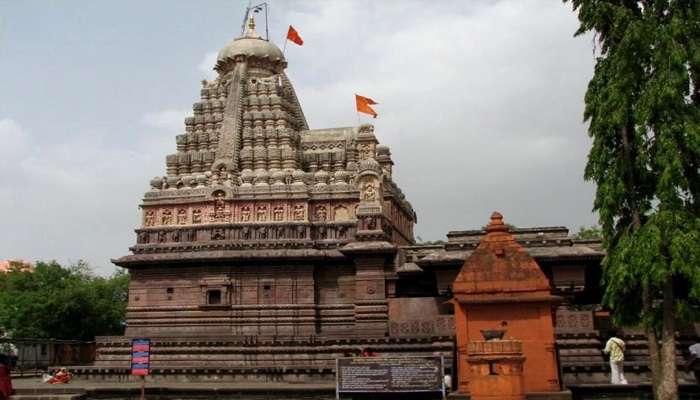
The architecture of the temple is marvellous and is a shining example of medieval Indian temple architecture. It stands adorned with fine and intricate carvings that are part of the extraordinary architecture of the temple. It is said that Queen Ahilyabai Holkar, the ruler from Indore, belonging to the Holkar dynasty, got this temple built in the 18th century, after the fall of the Mughal empire.
Grishneshwar mandir is built of red rocks and its structure comprises a five-tier spire or shikara. The court hall of the temple is built on 24 pillars, which hold the carvings of various legends and mythological stories of Lord Shiva. The walls of the temple display the Dashavatars or ten incarnations of Lord Vishnu carved beautifully in red stone. The pillars and walls are decorated with engravings, depicting the scenes from Hindu scriptures.
Must Read: Heritage Sites In Maharashtra
The Legend Of Grishneshwar Mandir Jyotirlinga
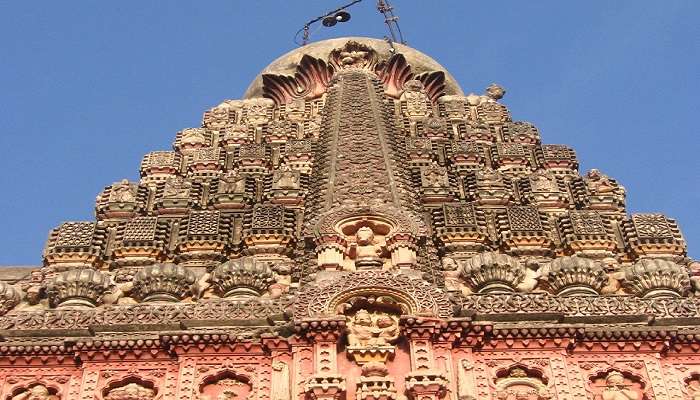
Grishneshwar mandir has been written about in the Shiva Purana and Padma Purana. After being destroyed by the Delhi Sultanate in the 13th-14th century AD, the site was redeveloped in the 16th century AD. Maratha ruler Shivaji Maharaj’s grandfather, Maloju Bhisale of Verul, got the temple reconstructed here. However, as we discussed earlier here, the current structure was built by Queen Ahilyabai Holkar of Indore in the 18th century AD.
According to one legend, a woman named Kusum used to worship Lord Shiva daily by immersing the Shiva Linga in water, while singing prayers to Him. This made her husband’s first wife extremely jealous of her devotion and in that rage, she murdered Kusum’s young son. Despite her utter grief, Kusum kept up her faith and devotion to Lord Shiva. Lord Shiva became pleased with her devotion and brought her dead son back to life. When Kusuma requested Lord Shiva not to leave but stay there forever, Lord Shiva manifested himself as a jyotirlinga and the temple was called Grishneshwar mandir.
Best Time To Visit
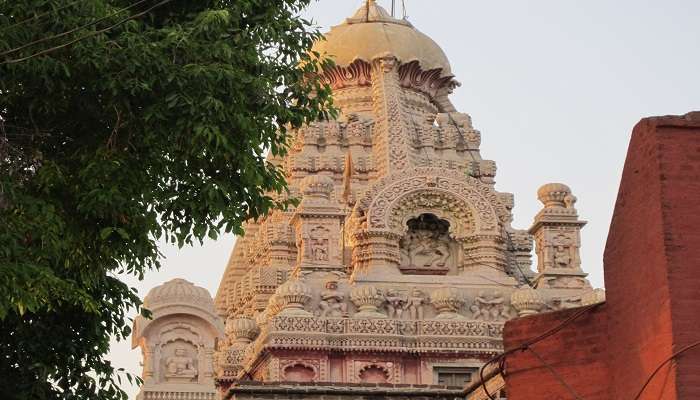
To have a memorable experience visiting this temple, we recommend you plan your visit between October and March, the winter months in India. In this season, the weather is amiable for outdoor exploration. However, you may also plan your visit to Grishneshwar mandir around the Mahashivratri festival. During this time, schedule your visit keeping in mind the crowded situations.
Suggested Read: Picnic Spots In Nashik
Grishneshwar Mandir Services
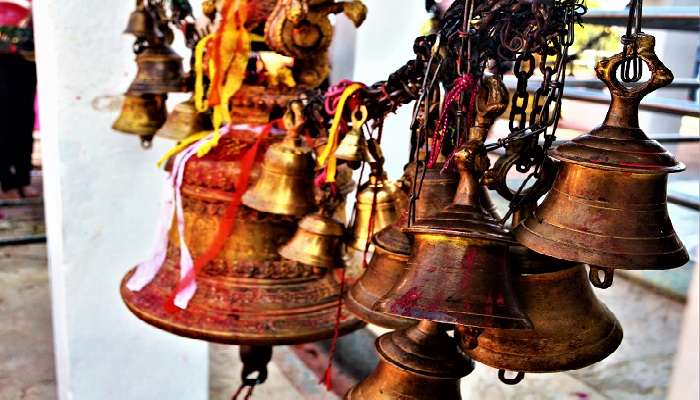
Grishneshwar Mandir complex offers numerous facilities and services to give temple visitors a comfortable experience. Aarti ceremonies are conducted throughout the day at the shrine, following the rituals. Devotees can take their pick from the several pooja services available at Grishneshwar mandir, such as abhishekam, Archana, and other special offerings seeking divine blessings.
The temple complex offers accommodation for overnight stays or extended visits. Annadanam provides essential food service free of cost to all devotees. You can contact the information counters and assistance desks for more information and support.
Grishneshwar Mandir Jyotirlinga aarti timings may vary depending on the season and festival. Mangal Aarti, the first aarti of the day, takes place at 4 AM. Jalhari Sanghan, the next aarti, is performed at 8 AM. Devotees can take the maha prasad at midnight. Sandhya Aarti, the evening aarti, is performed at 7:30 PM. Shayan Aarti, the last aarti of the day, is at 10 PM.
Places To Visit Nearby
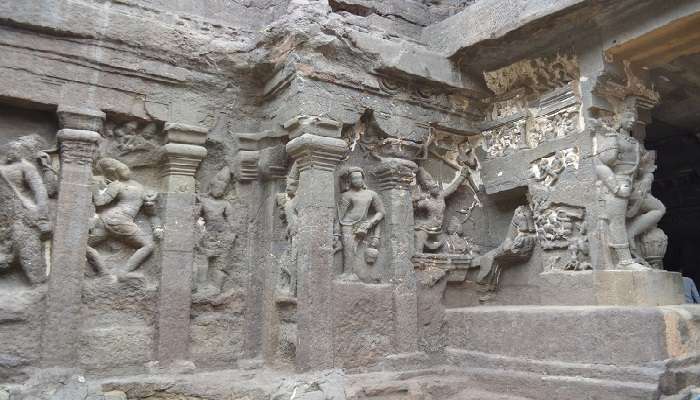
- Ellora Caves: A world-famous tourist destination and UNESCO World Heritage site, Ellora Caves are rock caves, having intricate religious carvings.
- Ajanta Caves: Also a UNESCO World Heritage site, Ajanta Caves showcases Buddhist rock monuments.
- Bibi Ka Maqbara: Fondly called the ‘Taj of the Deccan,’ Bibi Ka Maqbara is a mausoleum built by the Mughal Emperor Aurangzeb in the loving memory of his wife.
- Daulatabad Fort: Perched on a hill, this ancient fort offers scenic views of the nearby and makes it a must-visit destination.
- Grishneshwar Wildlife Sanctuary: Explore the natural diversity and wildlife of the Sahyadri mountain range.
Suggested Read: Picnic Spots In Mumbai
Local food Near Grishneshwar Mandir

Visitors looking for a sumptuous meal around Grishneshwar Mandir have many food options. You can indulge in local cuisines available around the temple premises, such as Maharashtrian poha, sabudana vada, kanda bhaji puran poli, and many more specialities.
How To Reach

Grishneshwar temple can be easily reached by road via Aurangabad. The city, just 3 kilometres away, is well-connected through Maharashtra State Transport buses. Since Ellora is a popular destination among tourists, there are frequent buses for Ellora caves daily. There are frequent taxi services available from Aurangabad to reach Grishneshwar mandir.
Further Read: Trekking Near Nagpur
Whether travelling for spiritual purposes or just for exploration, Maharashtra offers an array of scenic places to visit. Now that you have all the essential information about the Grishneshwar temple plan your trip to Aurangabad and visit the revered Lord Shiva temple today.
For our editorial codes of conduct and copyright disclaimer, please click here.
Cover Image Source: Rashmi. parab for Wikimedia
Frequently Asked Questions About Grishneshwar Mandir
What is the legend of Grishneshwar mandir?
Dedicated to Lord Shiva, Grishneshwar mandir is one of the 12 Jyotirlingas in India. The site was destroyed by the Delhi Sultanate in the 13th-14th century AD. However, in the 16th century AD, Maloju Bhisale of Verul, the grandfather of Shivaji Maharaj, got the temple rebuilt. This temple building was built by Queen Ahilyabai Holkar of Indore in the 18th century AD.
What are the Jyotirlingas?
The 12 Jyotirlingas are mentioned in Hindu scriptures and are revered highly by Hindus. Jyotirlinga or the pillars of light are the sacred shrines of Lord Shiva, as devotees believe that Lord Shiva has visited these places himself.
Which of the 12 Jyotirlinga to visit first?
Somnath temple, located in Gujarat, near Veraval, next to the Arabian Sea, is considered to be the first of the 12 Jyotirlingas in India.
Which of the 12 Jyotirlinga to visit last?
Grishneshwar Temple is an ancient Lord Shiva temple, near Aurangabad. It is considered the last of the 12 Jyotirlingas in India.
What is the timing of the Grishneshwar mandir?
The Grishneshwar mandir is open every day from 7 AM - 8 PM.
People Also Read:
Managaladevi Temple Jambukeswarar Temple Vindhyachal Mata Mandir

As a Travel Content Writer, I live to conquer the world of globetrotting with words. With my unquenchable thirst for storytelling, I believe that my words will inspire you to travel around the world’s breathtaking landscapes. As for me, I am an unapologetic selenophile, who loves to wander around in a starry night!











